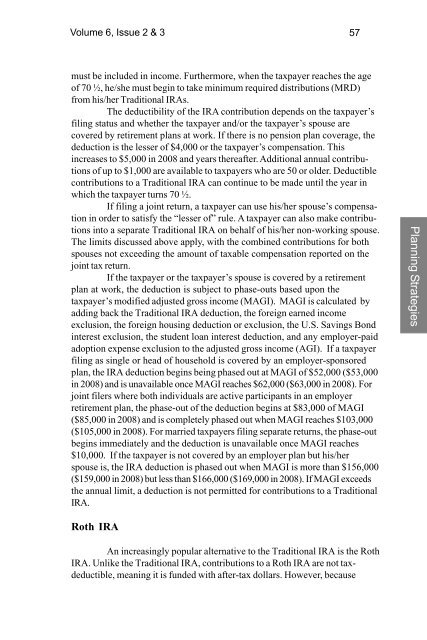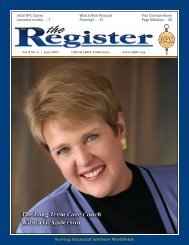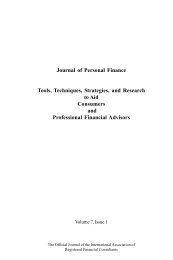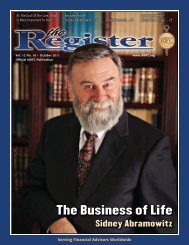3433-vol. 6 issue 2-3.pmd - iarfc
3433-vol. 6 issue 2-3.pmd - iarfc
3433-vol. 6 issue 2-3.pmd - iarfc
Create successful ePaper yourself
Turn your PDF publications into a flip-book with our unique Google optimized e-Paper software.
Volume 6, Issue 2 & 3 57<br />
must be included in income. Furthermore, when the taxpayer reaches the age<br />
of 70 ½, he/she must begin to take minimum required distributions (MRD)<br />
from his/her Traditional IRAs.<br />
The deductibility of the IRA contribution depends on the taxpayer’s<br />
filing status and whether the taxpayer and/or the taxpayer’s spouse are<br />
covered by retirement plans at work. If there is no pension plan coverage, the<br />
deduction is the lesser of $4,000 or the taxpayer’s compensation. This<br />
increases to $5,000 in 2008 and years thereafter. Additional annual contributions<br />
of up to $1,000 are available to taxpayers who are 50 or older. Deductible<br />
contributions to a Traditional IRA can continue to be made until the year in<br />
which the taxpayer turns 70 ½.<br />
If filing a joint return, a taxpayer can use his/her spouse’s compensation<br />
in order to satisfy the “lesser of” rule. A taxpayer can also make contributions<br />
into a separate Traditional IRA on behalf of his/her non-working spouse.<br />
The limits discussed above apply, with the combined contributions for both<br />
spouses not exceeding the amount of taxable compensation reported on the<br />
joint tax return.<br />
If the taxpayer or the taxpayer’s spouse is covered by a retirement<br />
plan at work, the deduction is subject to phase-outs based upon the<br />
taxpayer’s modified adjusted gross income (MAGI). MAGI is calculated by<br />
adding back the Traditional IRA deduction, the foreign earned income<br />
exclusion, the foreign housing deduction or exclusion, the U.S. Savings Bond<br />
interest exclusion, the student loan interest deduction, and any employer-paid<br />
adoption expense exclusion to the adjusted gross income (AGI). If a taxpayer<br />
filing as single or head of household is covered by an employer-sponsored<br />
plan, the IRA deduction begins being phased out at MAGI of $52,000 ($53,000<br />
in 2008) and is unavailable once MAGI reaches $62,000 ($63,000 in 2008). For<br />
joint filers where both individuals are active participants in an employer<br />
retirement plan, the phase-out of the deduction begins at $83,000 of MAGI<br />
($85,000 in 2008) and is completely phased out when MAGI reaches $103,000<br />
($105,000 in 2008). For married taxpayers filing separate returns, the phase-out<br />
begins immediately and the deduction is unavailable once MAGI reaches<br />
$10,000. If the taxpayer is not covered by an employer plan but his/her<br />
spouse is, the IRA deduction is phased out when MAGI is more than $156,000<br />
($159,000 in 2008) but less than $166,000 ($169,000 in 2008). If MAGI exceeds<br />
the annual limit, a deduction is not permitted for contributions to a Traditional<br />
IRA.<br />
Planning Strategies<br />
Roth IRA<br />
An increasingly popular alternative to the Traditional IRA is the Roth<br />
IRA. Unlike the Traditional IRA, contributions to a Roth IRA are not taxdeductible,<br />
meaning it is funded with after-tax dollars. However, because
















